#japanesehistory
Text
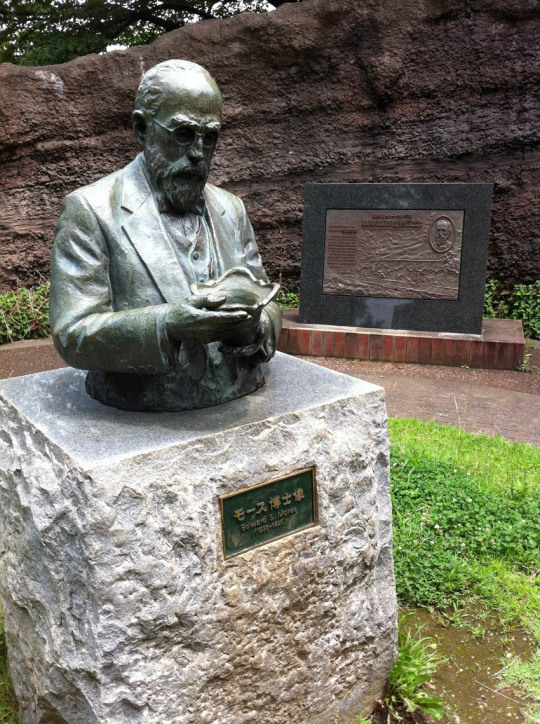
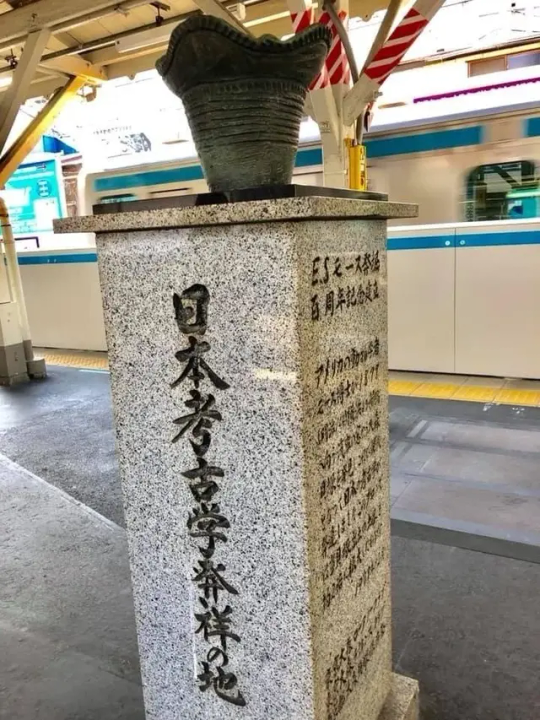

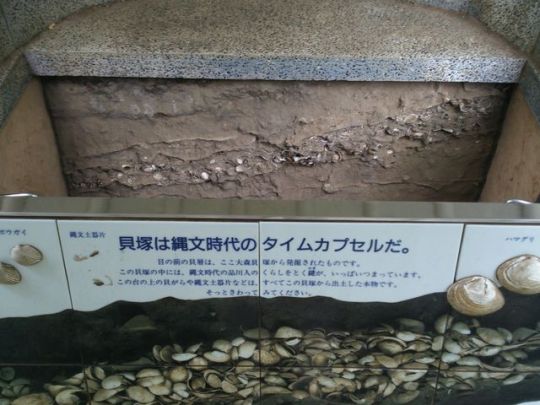
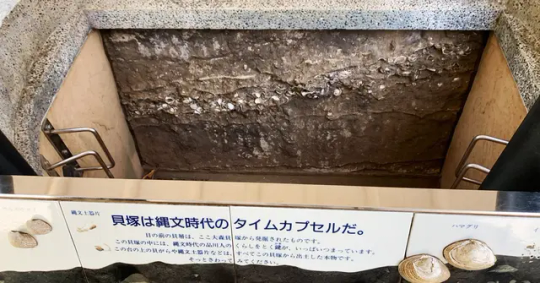
Sean bienvenidos japonistasarqueológicos, a una nueva entrega de arqueología japonesa, una vez dicho esto pónganse cómodos que empezamos.
-
En esta ocasión os voy a presentar al padre de la arqueología moderna japonesa Edward.S.Morse, zoólogo estadounidense del siglo XIX y gran apasionado por el mundo japonés, su hallazgo más relevante fue el montículo de conchas de Omori, cuando lo divisó desde el tren ha raíz de dicho hallazgo, fue venado descubrió la cultura prehistoria Jomon.
-
En la foto se puede apreciar el Montículo de conchas Omori en el momento de la excavación de Morse, en el año 1878 aproximadamente. ¿Lo conocían?
-
Espero que os haya gustado y nos vemos en próximas publicaciones, que pasen una buena semana.
-
日本の考古学者たちよ、ようこそ。そう言われたら、くつろいで、さっそく始めましょう。
-
今回は、近代日本考古学の父、エドワード・S・モース(19世紀アメリカの動物学者で、日本の世界をこよなく愛した人物)を紹介します。彼の最も重要な発見は、大森貝塚で、汽車から貝塚を発見したとき、先史時代の縄文文化を発見したのです。
-
写真は、1878年頃、モースが発掘した当時の大森貝塚です。 ご存知でしたか?
-
気に入っていただけたでしょうか、また今後の記事でお会いしましょう、良い一週間をお過ごしください。
-
Welcome, Japanese archaeologists, to a new installment of Japanese archaeology, and once that's been said, make yourselves comfortable and let's get started.
-
On this occasion I am going to introduce you to the father of modern Japanese archaeology Edward.S.Morse, 19th century American zoologist and great enthusiast for the Japanese world, his most relevant find was the Omori shell mound, when he spotted it from the train, he discovered the prehistoric Jomon culture.
-
The photo shows the Omori shell mound at the time of Morse's excavation in about 1878. Did you know it?
-
I hope you liked it and see you in future posts, have a nice week.
#日本#先史時代#旧石器時代#上毛時代#考古学#ユネスコ#遺跡#横浜#新橋#エドワードシルベスターモース#大森貝塚#日本史#-#japan#prehistory#palaeolithic#Jomoperiod#archaeology#unesco#archaeologicalsite#Yokohama#Shimbashi#EdwardSylvesterMorse#Omorishellmound#Japanesehistory
9 notes
·
View notes
Photo

Warriors of Japan: As Portrayed in the War Tales
Paul Varley, who passed away in 2015, was a professor of Japanese history at Columbia University for many years before coming to the University of Hawai’i. He specialized in the Kamakura and Muromachi periods. Varley's book, Warriors of Japan: As Portrayed in the War Tales, deals with a specific genre of Japanese literary work from his history specialty.
Japanese literature from the Nara and Heian periods mostly focused on the lives of the court aristocratic class, but, with the rise of the samurai class, a new style of writing called "war tales" emerged to reflect warrior values. War tales have two important scholarly values. First, they contain key historical information that is often absent in other sources. Second, they form an influential strand in Japanese literary traditions that successive generations of writers have drawn upon for inspiration. While Japanese war tales are significant primary sources, modern readers tend to perceive them as dull to read. In addition, like many historical texts and documents, the meaning of war tales is not always clear. For that reason, Varley's book is extremely valuable because it goes through the major war tales and provides complementary descriptions and explanations for these texts.
Continue reading...
40 notes
·
View notes
Photo

NOVA EDIÇÃO – História de um jeito descomplicado. De um passado milenar, universo de gueixas e samurais para a terceira maior potência econômica do globo. O Japão é conhecido mundialmente pelo trânsito entre o tradicional e o moderno, suas relações intrínsecas com a alta tecnologia e como difusor de uma das culturas populares mais vibrantes das últimas décadas. Tais impressões, porém, não são livres de distorções e estereótipos que são continuamente ventilados no senso comum. Embarque conosco na segunda edição do curso Entendendo a História do Japão, apresentando a História do arquipélago nipônico de uma maneira acessível, descomplicada e, é claro, crítica. Temas abordados: Mito de origem japonês, Compreendendo os Períodos e Eras no Japão, Da Restauração Meiji à Potência Econômica, Cenário Contemporâneo (relações com a China, Coreia do Norte, Coreia do Sul e Rússia) Quando: 29/3, 5/4, 12/4, 19/4 e 26/4, quartas, das 20h às 22h (BR) Inscrições no link da bio #japao #culturajaponesa #historiadojapao #historiajaponesa #japan #japaneseculture #historyofjapan #japanesehistory https://www.instagram.com/p/CqBOZfmOtsG/?igshid=NGJjMDIxMWI=
#japao#culturajaponesa#historiadojapao#historiajaponesa#japan#japaneseculture#historyofjapan#japanesehistory
8 notes
·
View notes
Text




5 notes
·
View notes
Photo

👹 『羅城門渡辺綱鬼腕斬之図 』 源頼光の四天王の筆頭・渡辺綱が、ある夜更けに京都一条堀川の戻り橋にさしかかったところ、美しい娘に夜も更けて恐ろしいので家まで送ってほしいと頼まれた。 綱が娘を馬に乗せてやると、たちまち鬼に姿を変え、綱の髪の毛を掴み空中に飛び上がって愛宕山に連れ去ろうとした。綱は少しも騒がず、源氏伝来の名刀「髭切」で鬼の腕を斬り落とし難を逃れたという。 “Watanabe no Tsuna Cutting the Arm of the Demon of Rashomon” Watanabe no Tsuna was the leader of the Four Guardian King retainers of Minamoto no Yorimitsu. One night, when he approached Modoribashi Bridge on Horikawa River at Ichijodori Street in Kyoto, he met a frightened girl, who asked the retainer to escort her home. As soon as he'd helped her on to his horse, she turned into a demon, grabbed his hair, jumped into the air and attempted to take him to Atago Mountain. He did not panic, nor make any sounds, and escaped the demon by cutting off her paw with his famous sword Higekiri, as told in the Tale of the Genji. UKIYO-E KURASHIKI STICKER ¥330 月岡芳年の千社札ステッカー! UKIYO-E KURASHIKIでは歌川国芳の門人にも光を当て、選りすぐりの浮世絵 約100作品を展示しております。 •岡山県倉敷市本町1-24 10:00-18:00(入館17:30まで) 火曜休館 [ ukiyo-e-kurashiki.jp ] #yoshitoshi #ukiyoe #woodblockprint #japaneseart #japaneseculture #japanesehistory #japantrip #katana #demonslayer #animationart #kurashiki #歌川国芳 #月岡芳年 #浮世絵 #髭切 #鬼 #刀剣 #美術 #倉敷美観地区 https://www.instagram.com/p/Cg_HLGmP12U/?igshid=NGJjMDIxMWI=
#yoshitoshi#ukiyoe#woodblockprint#japaneseart#japaneseculture#japanesehistory#japantrip#katana#demonslayer#animationart#kurashiki#歌川国芳#月岡芳年#浮世絵#髭切#鬼#刀剣#美術#倉敷美観地区
3 notes
·
View notes
Photo

Usagi Yojimbo! #haroartist #harostyle #havefunwithyourart #usagichronicles #theusagichronicles #samurairabbit #usagiyojimbo #stansakai #idwpublishing #darkhorsecomics #japanesehistory #japanesefolklore #mythicalcreatures #anime #animeharo #manga #mangaartist #mangaart #comicbookart #graphicnovels #usagiyojimboharo (at Central Valley, California, USA) https://www.instagram.com/p/CgcVQL3LIJY/?igshid=NGJjMDIxMWI=
#haroartist#harostyle#havefunwithyourart#usagichronicles#theusagichronicles#samurairabbit#usagiyojimbo#stansakai#idwpublishing#darkhorsecomics#japanesehistory#japanesefolklore#mythicalcreatures#anime#animeharo#manga#mangaartist#mangaart#comicbookart#graphicnovels#usagiyojimboharo
2 notes
·
View notes
Text
youtube
#youtube#japanese#japan#history#japaneseculture#culture#prehistory#stoneage#paleolithic#paleolithicjapan#japanesehistory
1 note
·
View note
Photo
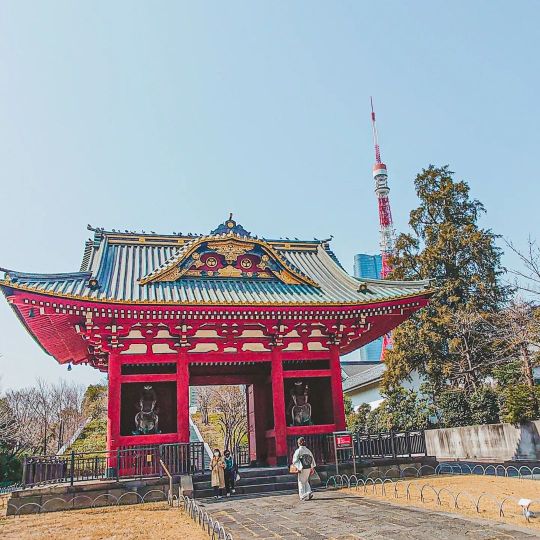
Yesterday we took a walk from Azabujuban shopping street to Shiba park and Zojoji. The very first day not wearing a coat! The virtual walk is on my YouTube channel (link in stories). I started these walks because I want to show my family back home the places I see - and I love Tokyo too much! The building was the main gate of the mausoleum of Hidetada Tokugawa, the second shogun of the Edo Shogunate, and is an important cultural property. The mausoleum was built on the south side of the precincts of Zojo-ji Temple in 1788, the year Hidetada died. It was the largest of the Tokugawa family mausoleums, but most of it was destroyed in the WWII raids. 🚇 Closer stations: Shibakoen (Mita line) and Akabanebashi (Oedo line). #shibakoen #shibapark #tokyotower #tokyotowerview #japaneseculture #japantourism #japanesecultureexperience #japanesehistory #japanesehistoryandculture #japanesehistoricalplace #zojoji #zojojitemple #東京タワー #東京タワー景色 #芝公園 #増上寺 #増上寺と東京タワー #virtualtravel #virtualwalk #virtualwalkthrough (presso Shiba Koen) https://www.instagram.com/p/CpsO4BiPsvy/?igshid=NGJjMDIxMWI=
#shibakoen#shibapark#tokyotower#tokyotowerview#japaneseculture#japantourism#japanesecultureexperience#japanesehistory#japanesehistoryandculture#japanesehistoricalplace#zojoji#zojojitemple#東京タワー#東京タワー景色#芝公園#増上寺#増上寺と東京タワー#virtualtravel#virtualwalk#virtualwalkthrough
0 notes
Photo

Around Nerima Station 🚉 #NerimaStation #TokyoLife #ExploreJapan #TokyoCityscape #DiscoverNerima #TokyoHiddenGems #NerimaCulture #JapaneseHistory #NerimaFoodie #TokyoNeighborhoods #NerimaStreetPhotography #TokyoWanderlust #NerimaSakura #TokyoAutumn #NerimaWinter #練馬駅 #東京暮らし #日本を探検 #東京都市景観 #発見練馬 #東京の隠れた宝石 #練馬文化 #日本の歴史 #練馬グルメ (at 練馬駅) https://www.instagram.com/p/Cphm_KirB5R/?igshid=NGJjMDIxMWI=
#nerimastation#tokyolife#explorejapan#tokyocityscape#discovernerima#tokyohiddengems#nerimaculture#japanesehistory#nerimafoodie#tokyoneighborhoods#nerimastreetphotography#tokyowanderlust#nerimasakura#tokyoautumn#nerimawinter#練馬駅#東京暮らし#日本を探検#東京都市景観#発見練馬#東京の隠れた宝石#練馬文化#日本の歴史#練馬グルメ
0 notes
Text
instagram
#mountainsofjapan#japan#mountain#mountains#japanesemountain#travel#japanesemountains#travelling#nature#hike#nagano#naganoprefecture#trail#japanesehistory#gifu#gifuprefecture#japanese#historical#edoperiod#history#edo#rivers#historicalbuildings#valley#kisovalley#nakasendo#river#explore#backpacking#backpacker
1 note
·
View note
Text
What Does the Term "No Mikoto" Mean in Japanese?
The term “No Mikoto” is a term that is commonly used in Japan, but not everyone knows what it means. In this post, we will explore the meaning and significance of “No Mikoto” in Japanese culture.
“No Mikoto” is a title used to refer to the legendary emperor of Japan who ruled during the 7th century. This emperor is revered as one of the greatest leaders in Japanese history and is remembered for…
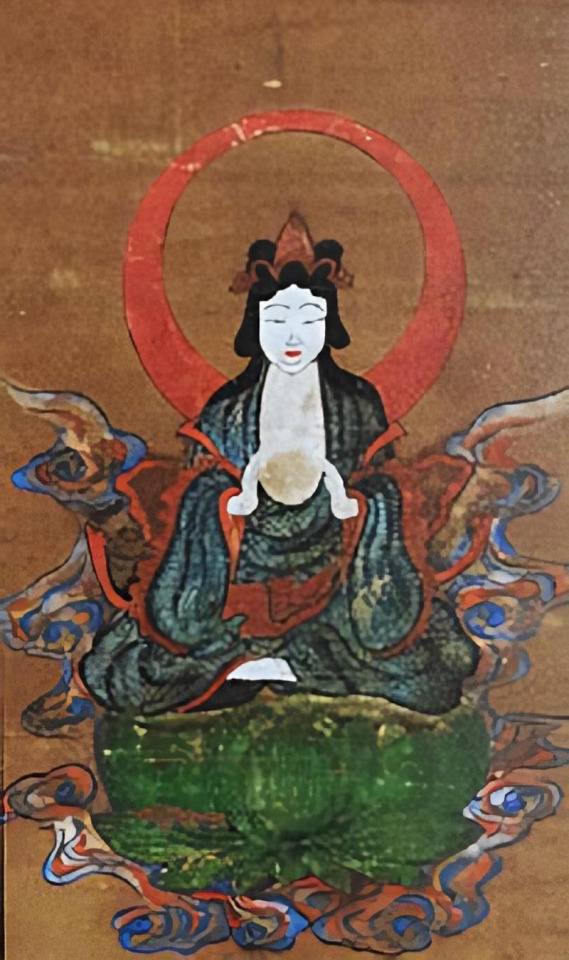
View On WordPress
#CulturalHeritage#Emperor#Heritage#JapaneseCulture#JapaneseHistory#JapaneseLegends#JapaneseMythology#JapaneseTradition#LegendaryEmperor#NoMikoto
0 notes
Photo

Reading Medieval Ruins: Urban Life and Destruction in Sixteenth-Century Japan
Although this is a wonderful read for anyone having a deep infatuation with Japanese history, it mostly appeals to a scholar or a reader who is somewhat familiar with the topic. This, however, should not discourage any passionate readers from attempting this book. Its language style and structure are straightforward. This book looks at Japanese history through the eyes of the author Morgan Pitelka and a common citizen living in the medieval Japanese city of Ichijōdani.
Pitelka avoids tediousness by using fluid language and vibrant imagery while still maintaining an educational and academic stance.
Pitelka's Reading Medieval Ruins contains nothing too logically complex to grasp. On the other hand, it deals with very specific subjects that a person looking for a general overview of Japanese history may not know the meanings or contexts of. An example of this is probably Pitelka's discussion on medieval Japanese medicine. It is an intriguing yet niche topic. Pitelka starts the discussion on medicine without providing much background information. From another perspective, regardless of whether one chooses to read it on its own or not, this book is a fascinating examination of a plethora of topics in a very tumultuous time in Japanese history.
Continue reading...
44 notes
·
View notes
Photo
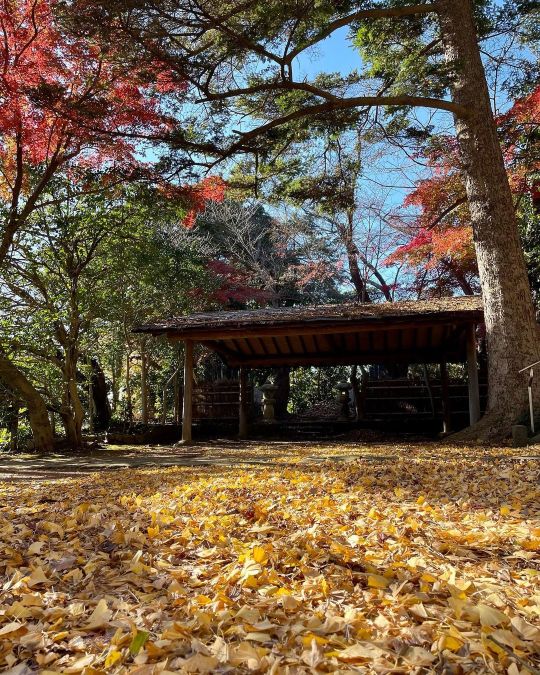
今月の #西原ゼミ 昼の部は、東京から お茶の先生、日舞の先生、敏腕キュレーターの3名様がいらっしゃいまして 美味しいランチをご一緒させていただいただけでなく 急遽 #お寺 見学まで便乗させていただきました♪ 行ってみたかったので嬉しい💕 贅沢なことに副住職様が 本堂で歴史のお話しから #需要文化財 の内部と #お庭 まで ご案内くださいました😃 ご一緒させていただき ありがとうございました♪ 今週は、なぜかたまたま #沼津 &お寺が続きましたね✨ #沼津市 #静岡県 #寺社 #japanesetemple #japanesegarden #redleaves #yellowleaves #紅葉 #もみじ #銀杏 #いちょう #秋の色 #numadu #japanesehistory #大中寺いも #日本の色 #茅葺 #山門 #日本建築 #和文化 #日本建築 #japanesearchitecture #architecture #japanesetraditional (at 大中寺 Daichuji) https://www.instagram.com/p/CmLrYJYye5k/?igshid=NGJjMDIxMWI=
#西原ゼミ#お寺#需要文化財#お庭#沼津#沼津市#静岡県#寺社#japanesetemple#japanesegarden#redleaves#yellowleaves#紅葉#もみじ#銀杏#いちょう#秋の色#numadu#japanesehistory#大中寺いも#日本の色#茅葺#山門#日本建築#和文化#japanesearchitecture#architecture#japanesetraditional
0 notes
Text
Lasting Last Stand: The Solemn and Sacred Ceilings of Japan
Japan is one of the oldest civilizations in the world and visiting can take someone back in time. Dotted throughout the country are well over 100,000 temples and shrines, some of which are over 1,000 years old. While these Buddhist temples and Shinto shrines are places of great reverence, sacred worship, and peace, there are a handful of them that tell a terrible tale quietly hidden in plain sight.
In 1598 Toyotomi Hideyoshi was approaching the end of his life, and it was coming after sixteen years of war culminating with Hideyoshi unifying Japan under his rule after more than two centuries of feudal warfare. To ensure that his hard-fought victory would not evaporate after his death he declared that upon his demise his rule would pass down to his son, five year old Toyotomi Hideyori. Obviously the young child could not serve the role, so until he was of age five regents from powerful families were appointed to rule on his behalf while pledging allegiance to Hideyori.
The alliance between the five regents was not strong and animosity, paranoia, and hunger for power soon began to crack the already-tenuous foundation. Ieyasu Tokugawa was arguably one of the most powerful of the regents, and he was firmly against Hideyoshi and his decisions. He quickly sieged Fushimi Castle from Toyotomi Hideyori and placed 2,000 troops there under the command of his trusted ally Torii Mototada. Another of the regents, Ishida Mitsunari, greatly distrusted Tokugawa and his motives and he began to stir problems and rebellions among the warlords in order to prevent Tokugawa from establishing an absolute rule. Mitsunari planned to draw Tokugawa out of Fushimi Castle so he could use his troops to take it back, and the plan worked. Spies informed Tokugawa that approximately 40,000 troops were headed toward Fushimi Castle and Tokugawa commanded Mototada to stay behind and defend the castle, allowing Tokugawa to flee westward in the attempt to quell the fighting incited by Mitsunari and keep his control over the region. When Tokugawa left Fushimi Castle he left Mototada and only 2,000 troops behind to face the approaching 40,000 men led by Mitsunari. He was told to defend the castle at all costs.

A replica of Fushimi Castle constructed in 1964 near the original site in Fushimi. Image via Wikimedia Commons.
Amazingly, Mototada and his 2,000 troops were able to defend the castle against Mitsunari for nearly twelve days despite being incredibly outnumbered in the brutal fighting. On July 30th 1600 the forces of Mitsunari broke through Mototada’s defenses and made their way into the castle, allegedly after being helped by someone on the inside.
The exact sequence of events has been lost to time, but Mototada and his remaining numbers (that has been written as being anywhere from ten to one hundred and seventy men) knew their cause was lost. Allegedly, Mototada came face to face with one of Mitsunari’s riflemen and promptly dared him to cut off his head, and the rifleman obliged, slicing it clean off his shoulders while the remaining men watched. Knowing the castle was lost Mototada’s remaining troops refused the cowardice of capture and amid the fires and turmoil they all committed seppuku, ritualistic suicide. The men each sliced open their own abdomen with a short sword before turning the blade and making a vertical cut upward causing them to bleed to death.
Mitsunari won back the castle, but the war was far from over and in the following weeks Tokugawa defeated Mitsunari’s forces in the decisive battle at Sekigahara. It was a victory that would reshape the history of Japan, Tokugawa Ieyasu became the first shōgun of the Tokugawa shogunate and His family ruled Japan for the next 268 years.
In 1623 Tokugawa had the Fushimi Castle dismantled. There was significant damage to the structure that told of its past, but the most startling sign of the turmoil was on the floor. When the forces of Mototada bled to death in the castle keep, there was so much blood that it deeply stained the floorboards with even bloody footprints still visible in the wood.
Over the course of twenty years Tokugawa and a priest had the wood taken up, placed in storage, and then distributed to multiple temples across Japan. The wood planks were installed in ceilings in order to honor the men who died defending the castle.

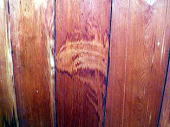
Two examples of the “blood ceilings” of Japan. Image via https://web.archive.org/web/20090705114401/http://www5f.biglobe.ne.jp/~toukondankon/b-toukonn.html
Today the chitenjo, or “blood ceilings” are visible at the temples of Genkoan, Shodenji, Yogenin, and Myoshinji in central Kyoto, Hosenin in the Ohara area, Jinouji in Yawata, and Koshoji in Uji.
More images of the ceilings can be found here and here.
******************************************************************************
Sources:
The Blood Soaked Ceilings of Kyoto by Alan J. Wiren.
https://www.japan-experience.com/all-about-japan/kyoto/temples-shrines/bloody-ceilings
Why Bloody Footprints Line the Ceilings of Kyoto's Genkoan Temple by James Gates.
https://theculturetrip.com/asia/japan/articles/the-chilling-story-behind-a-mass-samurai-suicide-in-ancient-kyoto/
Bloody Ceiling
https://ja.m.wikipedia.org/wiki/%E8%A1%80%E5%A4%A9%E4%BA%95
#husheduphistory#featuredarticles#JapanHistory#JapaneseHistory#HistoryWar#ShogunHistory#KyotoHistory#FamousWar#strangehistory#weirdhistory#forgottenhistory#tragichistory#historyclass#learnhistory#sadhistory#militaryhistory#HistoryofJapan#bloodceilings#memorial#historicmemorial#history#importanthistory#fushimicastle#historyisimportant#truestory#importantstories#tragictale
1 note
·
View note
Text


2022/11/25発売
「イラストで思わずわかる 日本近現代史」
イラスト約170点、担当しました。
発行:スタンダーズ・プレス株式会社さん
ブックデザイン:高橋コウイチ(WF)さん

0 notes
Photo

Hanafuda Earrings for July with iron tassels and sandstone beads! The exact meaning of Fumizuki is somewhat obscure. Some think that in the lazy days of midsummer, between the planting and harvesting seasons, people had time to write and read letters and poetry. Another theory is that the month was originally Fumuzuki which means “swollen month,” referring to the swelling rice grains in the fields. This may be another case of ateji distorting the meaning of the name. July is represented by the hagi (bush clover) and inoshishi (wild boar). The bush clover is related to the pea plant, and usually blooms in July through October. Wild boars are said to like to nest, or sleep, in the bush clover. Wild boars are one of the 12 animals of the Chinese zodiac, and are symbols of bravery and affection. However, to villagers in the mountains the boars can be dangerous pests that destroy crops and gardens. #hanafuda #july #birthmonth #zodiac #chinesezodiac #boar #koikoi #tassels #irontassels #statememtpiece #gemstones #sandstone #etsy #handmade #japanesehistory #japaneseculture #japan https://www.instagram.com/p/Cf3C5eIPGO1/?igshid=NGJjMDIxMWI=
#hanafuda#july#birthmonth#zodiac#chinesezodiac#boar#koikoi#tassels#irontassels#statememtpiece#gemstones#sandstone#etsy#handmade#japanesehistory#japaneseculture#japan
0 notes